| Top Ten NYC Architecture | top ten architectural styles | |
| For a more complete list, see Search by Style. | ||
| 1 | Neoclassicism (c.1780-1820) | |
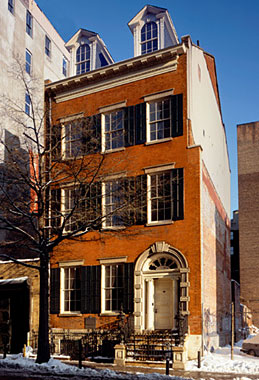 |
There are several variations: Federalist: Especially common in New England; a traditionalist approach to classicism, heavily influenced by English models. Charles Bulfinch, Samuel MacIntyre. Idealist: An intellectual and moral approach to classicism, at first linked to Roman models. Symbolic and associational values stressed. Best example: Thomas Jefferson. Rationalist: Emphasized structure and classical building techniques, such as stone vaulting and domes. Benjamin Latrobe. |
|
| 2 | Greek Revival (1818-1850) | |
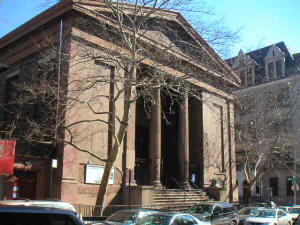 |
The first truly
national style in the United States. Strong associational values. Permeated all levels of building. |
|
| 3 | Gothic Revival (c. 1820-1860) | |
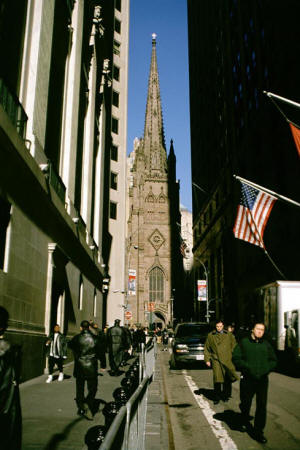 |
Strong
associational values of religion and nature. Found in both
ecclesiastical and residential architecture. A wide range of archaeological accuracy, from Richard Upjohn's urban churches to "Carpenter's Gothic" cottages. |
|
| 4 | Second Empire Baroque (1860-1880) | |
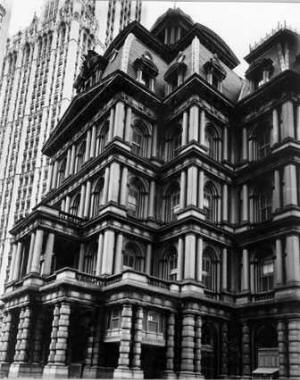 |
French origin; used for public and residential architecture. | |
| 5 | Beaux-Arts Classicism and Renaissance Revival.(1885-1920) | |
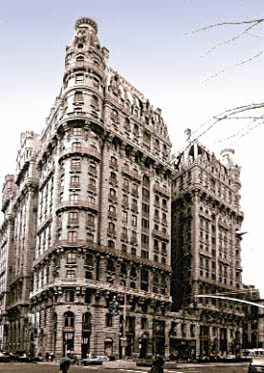 |
Drawn from the architecture of 15th- through 17th-century Italy, France and England. On this side of the Atlantic, Italian palazzi, French chateaux, and English clubs became the stylistic image for banking institutions, super town houses, clubs and government buildings, and even mercantile establishments (cf. the Federal Reserve Bank of New York and many of SoHo s cast-iron loft buildings). Proselytized through the Ecole des Beaux-Arts in Paris, the Beaux Arts style, from about 1890 to 1920, inflated classical allusions to truly supergrandiose proportions, as at Grand Central Terminal, the Custom House at Bowling Green, and the New York Public Library. | |
| 6 | Setback Style Skyscrapers (1920-1950) | |
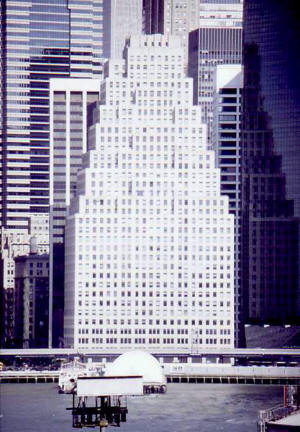 |
The "Wedding Cake" style
refers to buildings with many distinct tiers, each set back from the one
below resulting in a shape like a wedding cake. The style is almost
exclusive to New York City, thanks to the 1916 zoning code ( prompted by
the "shocking" height and verticality of the
EQUITABLE BUILDING ) which
forced buildings to reduce their shadows at street level, but occasional
examples are found in other cities with dense business districts.
Wedding Cake buildings range across a spectrum of early-to-mid-20th century stylistic treatments, some with eclectic or art moderne facades and some modern or international. The buildings can be grouped into one style because their setbacks are usually their most distinguishing design feature. |
|
| 7 | Art Deco (1925-1940) | |
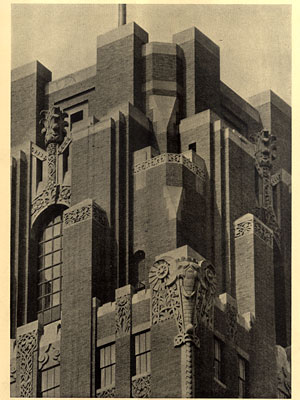 |
The largely French-inspired styles of the era between World Wars I and
II, when cubistic structures were embellished by the use of florid
ornament inspired by the Paris Exposition of 1925 (Art Deco) and later
by sleek streamlined ornament that also influenced the Paris Exposition
of 1937 ' Art Moderne . Many polychromed works of Ely Jacques Kahn
exemplify Art Deco: the corner-windowed “modernistic” apartment houses
of the Grand Concourse in the Bronx
and the Majestic Apartments, at Central Park West and 72nd street
are Art Moderne.
Both Deco and Moderne use setbacks to reduce building mass and to emphasize verticality. Unlike "Wedding Cake" buildings, their shapes recede from the street gracefully, not in tiers but in gentler and more carefully positioned steps. Limestone is the most common cladding material, with brick facades common in Art Deco. Prominent architects in the style include Shreve, Lamb & Harmon Associates, Bertram Grosvenor Goodhue, and Lawrence Murray Dixon. |
|
| 8 | International Style (1945-1970) | |
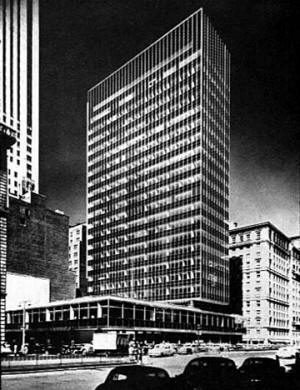 |
After about 1960 modernism began to play more freely with shapes and structures, producing a wider variety of designs including cylindrical buildings, sloping roofs, and unusual shapes. This trend runs parallel to Postmodernism, which rebelled against the strictness of modernism by reviving historical tropes; but during this period the aesthetic and economic advantages of simplicity kept modernism alive in all parts of the world. One of the leading proponents of modernism is the architecture firm Walter Gropius, which has also worked in other styles but is closely associated with the evolution of 20th century modernism. An equivalent firm in the Far East is the Japanese company Nikken Sekkei Ltd., and one of the most famous design firms of the late modern period is The Stubbins Associates, Inc., architects of Yokohama Landmark Tower and Citigroup Center. |
|
| 9 | Late Modern (1970-present) | |
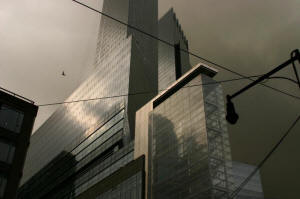 |
Philip Johnson
(before his conversion to Post-Modernism) and I.M. Pei, among others. Late Twentieth-Century Late Modern buildings avoided most of the allusions, irony and self- mockery of post-modernism, although they sometimes paid homage to Inter-War Functionalism. They also modified the uncomplicated, predictable matchbox shapes of the International style by slicing, chamfering or serrating them, by stressing the 45-degree angle in plan and elevation, or by relinquishing the rectangular prism in favour of pyramidal, cylindrical or free-curved shapes. Late Modern architecture was nothing if not sleek and glossy. It strove to convey the image of the formidable technology of the computer and the satellite, a technology that was not yet practical for everyday use in the building industry even though it appeared overseas in such tours de force as the HongKong and Shanghai Bank and the Lloyds of London Building. |
|
| 10 | Post-Modernism (1964-present) | |
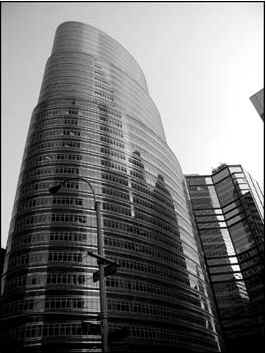 |
Postmodern architecture is a counter reaction
to the the strict and almost universal modernism of the mid-20th
century. It reintroduces elements from historical building styles,
although usually without their high level of detail. Common features
include columns, pyramids, arches, obelisks, unusual or
attention-getting shapes and rooflines, and combinations of stone and
glass on the facade.
Postmodernism ranges from conservative imitations of classical architecture to flamboyant and playfully outrageous designs. As the style became mainstream, many buildings with a modern form assimilated postmodern devices into small parts of their designs. Among the original and most prototypically postmodern architects, Michael Graves & Associates is famous for its colorful and entertaining designs in architecture and other products. The firm of Johnson/Burgee Architects has designed some of the style's best known buildings, with an extremely wide variety of forms. Kohn Pedersen Fox Associates is one of the most successful practices in history, with a portfolio of major postmodern buildings all over the world. |
|